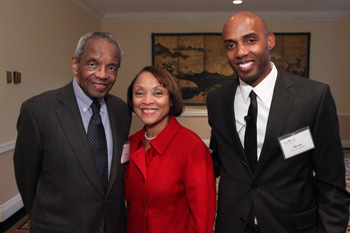 Professor Devon Carbado of UCLA School of Law delved into the complexities of assessing laws through the prism of race on November 3 when he delivered the 15th annual Derrick Bell Lecture on Race in American Society, “After Obama: Three ‘Post-Racial’ Challenges.”
Professor Devon Carbado of UCLA School of Law delved into the complexities of assessing laws through the prism of race on November 3 when he delivered the 15th annual Derrick Bell Lecture on Race in American Society, “After Obama: Three ‘Post-Racial’ Challenges.”
The challenges of the lecture’s title involved these three questions: What is discrimination on the basis of race? What is racial preference? What is colorblindness? “The idea is to go back to first principles and questions that have long been a part of our civil rights discourse,” Carbado said in an interview before the lecture, “and raise questions about whether our answers to those questions are satisfying.”
Often missing in contemporary discourse on race, he continued, is the matter of intraracial, rather than interracial, discrimination. While everyone recognizes a biased preference for one race over another, Carbado said, preference for certain individuals over others within a single race is less often recognized: “Here the question is not whether an institution might prefer white over black, but whether an institution might prefer one black over another. So it’s not total exclusion, it’s not complete bars, it’s rather selective inclusion.”
Carbado began his lecture with an examination of what race means as a social construction. He suggested that phenotype and ancestry aren’t the only factors in racial mapping—so are such things as dress, religion, level of assimilation, and speech. Those factors contribute to racial identification, he said, triggering stereotypes that in turn lead to discrimination.
One aspect of that racial identification, Carbado said, was “racial salience,” leading, for example, to the idea of “degrees of blackness.” (A Time headline from 2007 asked, “Is Obama Black Enough?”) Such perspectives, he continued, manifest themselves in intraracial discrimination: “Part of our post-racial challenge after Obama is to take more seriously intra-group differences.” Thus, for example, even if both candidates for a particular job are of the same race, discrimination can still occur in the process of choosing one candidate over another.
Turning to racial preference, Carbado identified affirmative action as the area most closely identified with that concept. The courts now apply a strict scrutiny framework in assessing the constitutionality of affirmative action policies, but, Carbado suggested, incorrect assumptions are applied in those assessments.
There is the assumption of a level playing field where affirmative action is a thumb tipping the scale, he said, but that idea did not account for preexisting “tipping” against certain groups in favor of others. The strict scrutiny framework, Carbado continued, has repercussions not just in the area of admissions, but also in voting rights, employment discrimination, and voluntary integration.
Turning last to the concept of colorblindness, Carbado characterized it as a normative claim that people should not see race (even if they do), in order to achieve “race neutrality.” Carbado offered the example of a minority student writing a personal statement as part of an admissions application. Stripping personal stories of anything potentially racially identifying robs the narrative of its meaning, he said, arguing that the result is not racially neutral but rather choosing one approach to the issue of race over another.
Carbado harbored no illusions about providing definitive answers to the questions he had introduced. But, he concluded, “Engaging the three problems as I posed them at least engenders a rethinking about some of our most fundamental assumptions of race, and that I’m hoping will open up doctrinal space for more anti-racist possibilities than currently exist.”
Posted on November 22, 2010